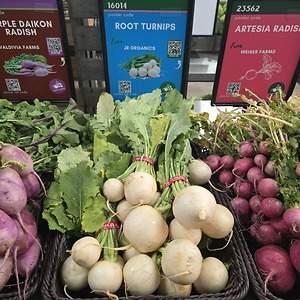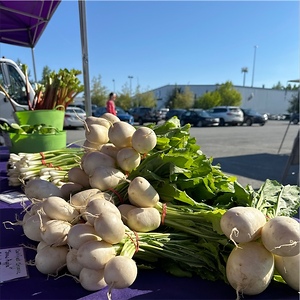


Japanese Turnips
Estimated Inventory, bunch : 0
Description/Taste
Japanese turnips are small in size, averaging 2 to 5 centimeters in diameter, and have a round to oval shape with curved shoulders tapering to an elongated, pointed tip. The turnip’s skin is thin, smooth, taut, and hard, showcasing white to cream-colored hues. Underneath the surface, the white to ivory flesh is dense, aqueous, and crunchy, with a snappy, crisp, and succulent consistency. Japanese turnips are edible raw or cooked and have a mild, sweet, subtly peppery, and slightly fruity flavor. The green leaves are also edible and have an elongated, broad, and frilly nature. The glossy leaves have prominent veining and a crisp and slightly chewy texture. Like the turnips, Japanese turnip leaves are edible raw or cooked and have a peppery, green, and vegetal taste.
Seasons/Availability
Japanese turnips are available year-round with varying harvest dates, depending on the cultivation region. In Japan, the fast-growing turnips have a peak season between October to April.
Current Facts
Japanese turnips, botanically classified as Brassica rapa, are a category of small varietals belonging to the Brassicaceae family. The name Japanese turnip is a general descriptor used in English-speaking communities to describe tender, sweet, and mild turnip varieties commercially developed in Japan for culinary use. Japanese turnips are also known as Hakurei turnips, Tokyo turnips, Tokyo Market turnips, Suzuna, Kaburana, Kanamachi, Kabura, Kabu, and Salad turnips. In Japan, these turnips are one of the most popular types marketed for fresh eating as they mature early, sometimes in as little as 30 to 38 days, and have a mild flavor. Growers also value the turnips for their fast-growing nature, hot and cold weather tolerance, and zero waste nature. Japanese turnips are entirely edible, including the roots, stems, and leaves, and have a mild, sweet, and subtly peppery taste popularly incorporated into a wide array of fresh or cooked culinary preparations.
Nutritional Value
Japanese turnips are considered a nutritious ingredient in culinary dishes throughout Japan, believed to help ward off colds and other sicknesses. Turnips are also known as the swollen taproot of the plant and are a source of vitamin C, fiber, and potassium. Vitamin C strengthens the immune system, fiber regulates the digestive tract, and potassium balances fluid levels within the body and helps replenish electrolytes. The taproots also contain diastase, a digestive enzyme that helps to break down starches for improved digestion. Japanese turnip leaves provide vitamins A, C, and K and iron, calcium, and B vitamins. Vitamin A aids in maintaining overall organ health, while vitamin K helps the blood coagulate for faster wound healing. Iron develops the protein hemoglobin for oxygen transport through the bloodstream and calcium supports bones and teeth.
Applications
Japanese turnips have a mild, sweet, subtly peppery, and slightly fruity taste suited for fresh and cooked preparations. The small swollen roots are edible raw and do not need to be peeled before use, but they should be washed prior to consumption. In Japan, turnips are popularly prepared with a small portion of their green stems still attached. These edible stems provide a small handle to pick up the entire root when eating. Japanese turnips are often consumed raw on crudité platters or shredded or grated over salads. They can also be sliced thin and tossed with olive oil, citrus juice, seasonings, and cheeses as a fresh dish or sliced and stuffed into sandwiches. In addition to fresh preparations, Japanese turnips can be cooked and are commonly sauteed, pan-seared, roasted, or boiled. The roots are often tossed with savory glazes, sauces, and seasonings to create a rich dish and are served as a simple side to meat main courses. They can also be fried to create a crunchy texture or incorporated into soups and stews. The leaves and stems are edible raw or cooked and are commonly cooked and tossed with the roots. Japanese turnips pair well with ginger, garlic, soy sauce, sesame, miso, citrus, apples, carrots, cabbage, and sunflower seeds. Whole, unwashed Japanese turnips should be separated from their stems and leaves, wrapped in paper towels to absorb excess moisture, and stored in a plastic bag for about one week. The leaves should be used for the best quality and flavor within a few days of purchase.
Ethnic/Cultural Info
Turnips are regarded as one of the Seven Herbs of Spring in Japan and are traditionally consumed as a part of the Jinjitsu festival, also known as Nanakusa No Sekku, meaning “The Feast of the Seven Herbs.” The festival is annually held on January 7th and is thought to date back to the Heian Period, from 794 to 1185 CE. The Jinjitsu festival is rooted in Chinese origin, and when it was introduced to Japan, it combined with ancient Japanese customs to create a time of consuming nutritious ingredients to cleanse the digestive tract. Each year, seven-herb rice porridge is made from seven regional ingredients, the most traditional being turnips, daikon radishes, Japanese parsley, shepherd’s purse, henbit, chickweed, and cotton weed. Turnips are generally known as Suzuna in Japan, which roughly translates to “a bell that calls the gods.” All seven ingredients are considered auspicious and are believed to welcome good luck and health in the year to come while warding off evil and illnesses. Historically, the seven-ingredient dish was comprised of various grains, but in the Kamakura Period, 1185 to 1333 CE, herbs and vegetables were substituted for grains. Beyond good health, consuming seven-herb rice porridge is considered a cleansing dish that helps transition the stomach after consuming rich foods during the holiday season. This holiday marks the changing of the seasons and is a community-wide event to pray for longevity and health and prepare for the new season to come.
Geography/History
Japanese turnips are native to Japan and were developed from varieties introduced during ancient times. Western-type turnips, in general, arose from various regions in the Middle East and Europe, specifically in the Hindu Kush mountains, an area a part of modern-day Afghanistan, and also in the Mediterranean. Over time, these turnip varieties were transported along trade routes and were carried into Japan through the Korean Peninsula. Western turnips were hypothesized to have been introduced to Japan around the Yayoi Period, from 300 BCE to 250 CE, but the root vegetable did not become commercially popular until the mid-20th century. During this time, the aftermath of World War II caused many villages in Japan to suffer from famines. Turnips were fast-growing, tolerant of extreme weather changes, and had extended storage properties, leading them to become a valued crop for commercial production and home garden cultivation. Japanese breeders in the late 20th century also created improved varieties of turnips for cultivation, including White Salad turnips, and these roots later became generally known as Japanese turnips worldwide. It is also important to note that improved varieties of small, white turnips have been continuously bred over time and are all generally categorized under Japanese turnips. Today, Japanese turnips are primarily grown in Japan but are also cultivated worldwide as a specialty variety. When in season, the small root vegetables can be seen through local markets and select retailers.
Recipe Ideas
Recipes that include Japanese Turnips. One

















